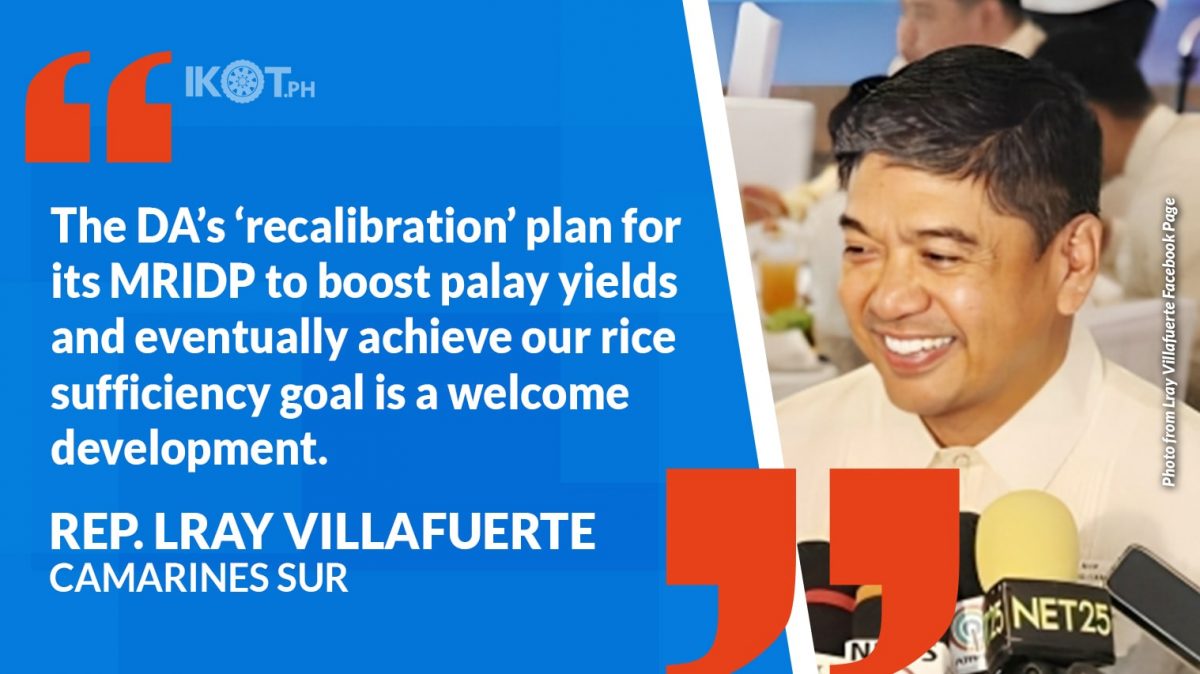National Unity Party (NUP) president LRay Villafuerte has welcomed a Department of Agriculture (DA) plan to “recalibrate” its Masagana Rice Industry Development Program (MRIDP) to further boost palay harvests, as he proposed to Secretary Francis Tiu Laurel to consider a game-changing subsidy-cum-contract-growing idea that will let government sell the staple at P20 per kilogram (kg) to poor families and at P30 to all other consumers.
“The DA’s ‘recalibration’ plan for its MRIDP to boost palay yields and eventually achieve our rice sufficiency goal is a welcome development, and I hope that in pursuit of this planned overhaul, Secretary Kiko (Laurel) considers a game-changing subsidy-cum-procurement program that will enable our farmers to yield 5 million MT (metric tons) or 5 billion kg, leading to a drastic drop in the per-kg retail cost of rice to just P20 to P30,” Villafuerte said.
Under Villafuerte’s proposal, which he initially raised last year, the government shall allocate P40 billion in subsidies for farmers tilling a combined one million hectares (ha) in provinces that are the country’s 10 biggest palay producers, with the goal of yielding a post-milling total of 3 billion kg, which the government will then buy from the subsidized farmers in the “Top 10” palay-growing provinces at P9 per kg.
Every farmer-beneficiary shall get a subsidy of P40,000 per ha to enable each one to produce the targeted yield of 5 MT or 5,000 kg per ha, or 3 MT or 3,000 kg per ha after milling.
The conversion rate of palay to rice after milling is 60%.
With this proposed subsidy and procurement setup, Villafuerte said the estimated total yield of 3 million MT will allow the government to sell 1.5 billion kg of rice at P20 a kg to poor and low-income families and another 1.5 billion kg at P30 to the rest of consumers.
Villafuerte noted that with the government spending about P40 billion in yearly subsidies on the rice subsector, ‘the DA could consider using this amount instead for a new subsidy-cum-procurement program under the MRIDP for small farmers tilling an initial total land area of one million hectares (ha) in the ‘Top 10’ palay producers in the country, at a financial aid of P40,000 per hectare for every target farmer-beneficiary.”
A former governor of Camarines Sur (CamSur) that is one of the country’s ‘Top 10” palay growers, Villafuerte suggested that the would-be farmer-beneficiaries in the biggest palay-producing provinces be selected by the DA in tandem with the local government units (LGUs).
Laurel said that the DA plans to “recalibrate” its MRIDP in an effort to raise yield to 7.5 MT or 150 50-kg bags per ha, or almost double the current national yield of 4.17 MT or 84 bags.
Laurel said that the DA plans to “recalibrate” its MRIDP in an effort to raise yield to 7.5 MT or 150 50-kg bags per ha, or almost double the current national yield of 4.17 MT or 84 bags.
“We’re recalibrating the program to identify areas for enhancement, including the distribution of improved seeds, expansion of irrigation systems and adjustments to rice cropping schedules,” Laurel said.
The current average per-ha yield is 4.51 MT in irrigated areas and 3.34 MT in non-irrigated areas.
According to the United States Department of Agriculture (USDA), the Philippines will be the world’s largest rice importer for the third year in a row in 2025 with projected imports of 4.2 million MT.
According to the DA price watch Bantay Presyo, WMR prices in public markets stood at P52.60 to P50.43 per kilo, as of mid-August, while regular milled rice (RMR) prices were at P47.93 to P47.44 per kilo.
“Contrary to the contention of our agriculture officials that selling rice at P20 a kilo, although possible, cannot happen in the near future, market rates of P20 and P30 a kilo are actually doable if we are to adopt a novel palay productivity program involving the grant of a pre-planting subsidy of P40,000 per hectare to target farmer-beneficiaries tilling a total of a million hectares in our 10 biggest palay-producing provinces, but on condition that these farmers sell their produce to the government at P9 a kilo,” Villafuerte said.
He said the targeted total yield of 5 billion kg of palay from the one million ha, based on an average output of 5 MT or 5,000 kg per ha, will translate into 3 billion kg of rice, based on the palay-to-rice, after-milling conversion rate of 60%.
Villafuerte explained that under his proposed MRIDP reform, farmer-beneficiaries will be required to sell their produce to the government at a fixed rate of P9 per kg of palay, he said, which means the government will have to set aside P45 billion for this proposed procurement component of the subsidy plan.
In buying the farmers’ produce after already giving them P40,000 each before the start of the planting season, Villafuerte said this will encourage the beneficiaries to produce more from their respective farms as they will be paid P9 for every kilo of palay they are able to produce.
With this proposed subsidy and procurement setup, Villafuerte said the estimated total yield of 3 million MT will allow the government to sell 1.5 billion kg of rice at P20 a kg to poor and low-income families and another 1.5 billion kg at P30 to the rest of consumers.
He said that in order to further incentivize the farmer-beneficiaries to produce more of the grain from their croplands, he said that cash prizes and/or farm machinery like power tillers and harvesters, fertilizers and other inputs can be offered to the farmers garnering the highest per-hectare yields in the chosen provinces.
Also, he said, cash prizes or other rewards can likewise be given to the LGUs of the provinces where their farmer-beneficiaries achieved the highest per-hectare yields.
On Villafuerte’s watch as three-term CamSur governor from 2004 to 2013, the province—according to the Bureau of Agricultural Statistics (BAS)—became the country’s 12th biggest rice producer in 2008 and a higher No. 8 in 2011. CamSur went up to No. 4 rice producer in 2016.
Villafuerte said that of the post-milling projected output of 3 billion kg of rice, the government can sell 1.5 billion kg or half of it at P20 a kilo through the President’s pet project Kadiwa ng Pangulo outlets nationwide for poor and other low-income families, and the remaining 1.5 billion kg at a higher P30 via retail markets for the benefit of other consumers.
The government will earn P30 billion from selling 1.5 billion kg of rice at P20 and P45 billion more from selling the other 1.5 billion kg at the higher P30 kilo, or a total of P75 billion, he said.
“Thus, at the end of this undertaking, the government will have spent just P10 billion in subsidies for the rice productivity program—in lieu of the current P40 billion—after collecting P75 billion in rice sales and deducting this amount from the P85 billion set aside for the farmers’ subsidy-and-grains-procurement plan,” said Villafuerte.
He said it will be up to the DA, in coordination with the concerned LGUs, to decide on whether to give the P40,000-per-hectare subsidy to the target farmer-beneficiaries in cash, in the form of inputs like high-yield seeds and fertilizer, or a combination of cash and farm inputs.
Villafuerte suggested limiting the pilot phase of this proposed program to target beneficiaries in the biggest palay-growing provinces because the farmers in these places have already been tested-and-proven to produce higher yields.
However, after the pilot year, this program can be expanded over the succeeding years to cover additional beneficiary-farmers in another one (1) million to two (million) ha in provinces other than the “Top 10” palay-growing provinces, he said.
“With this palay-procurement component, the proposed rice productivity project might even produce more than the projected 5 billion kilos of palay from the one million hectares because the beneficiary-farmers will be incentivized to produce more palay so they can earn more money from their farms at the buying rate of P9 per kilo,” he said.
The farmers will likewise be encouraged to produce the biggest harvests from their lands in the hope of winning the cash or in-kind rewards that await the project beneficiaries who come up with the highest yields per hectare, he added.
Alongside the P40-billion outlay for the subsidy plan that will be given to the target farmer-beneficiaries in the 10 biggest palay-producing provinces before the start of the planting season, this P45-billion budget for buying the farmers’ produce will add up to a total of P85 billion for the entire project.
Funding for this rice productivity program can be sourced from the annual General Appropriations Act (GAA), a Congress-approved supplemental fund, or from the collections from rice import tariffs in excess of the P10-billion allocated annually for the Rice Competitiveness Enhancement Fund (RCEF) under Republic Act (RA) 11203 or the Rice Tariffication Law (RTL).
Villafuerte is a co-author of both RA 11203 and the House-approved HB 10381 or proposed amendatory law extending the RTL by six years and increasing the annual RCEF budget from P10 billion to P15 billion.
“This proposed MRIDP reform is an excellent solution because we will be providing needed production assistance to our palay growers that will stop them from seeking pre-planting loans from usurers or unscrupulous traders and then selling their produce to them at dirt cheap prices, while at the same time boosting our harvests and enabling rice consumers to buy the staple in retail markets at only P20 to P30 per kilo,” Villafuerte said.
“We must not forget that our farmers will benefit, too, from cheaper rice because they themselves eat the staple and eventually buy their rice from the market like other Filipino consumers,” he said.
“The projected bigger palay harvests, on top of helping stabilize domestic supply and eventually pulling down the cost of rice in the local market, will lead to lower import volumes of the staple, thereby conserving our precious dollar reserves,” he added.
Villafuerte said his proposal is in sync with the Marcos government’s initiatives to provide financial assistance to palay growers, boost their productivity, reduce our dependence on imports, and provide consumers, especially the poor and other vulnerable groups, with greater access to cheaper rice.
According to 2017 PSA data, the “Top 10” palay-producing provinces are Nueva Ecija at No. 1 with 1.884 million MT; followed by Isabela at No. 2, with 1.286 million MT; Pangasinan at No. 3 with 1.125 million MT; Cagayan at No. 4 with 1.006 million MT; Iloilo at No. 5 with 937,000 MT; CamSur at No. 6 with 683,000 MT; Tarlac at No. 7 with 579,000 MT; North Cotabato at No. 8 with 500,000 MT; Leyte at No. 9 with 481,000 MT; and Negros Occidental at No. 10 with 475,000 MT.
The national average yield over the 2002-2022 period was 4.11 MT per hectare, said the PSA.



